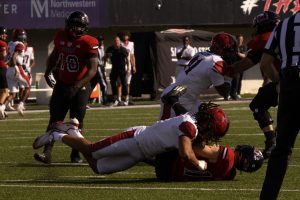Learning to deal with liquor
October 20, 1987
Alcohol is the basis of many social events and good times on campus—just look at the facts:
Thousands more students turn up for the tailgating before a Huskie football game than actually attend the game.
DeKalb bars are crammed with area residents each weekend as people consume hundreds of gallons of alcohol with friends.
Turning 21 is one of the most important events for many college students, and many who cannot wait obtain a fake ID to get into the bars.
Alcohol is, unfortunately for some, an early and possibly disasterous end to social events and good times as well. This also is made evident by some recent facts:
Several people were injured, including one University Police officer, as a result of excessive tailgating rowdiness before NIU’s opening game Sept. 12.
A student bled to death Sept. 18 after falling and cutting himself on a drinking glass he had taken from a nearby bar.
One student died and two were seriously injured as their car was hit from behind Oct. 4 by an intoxicated driver going about 90 miles per hour.
A 17-year-old was seriously injured Oct. 11 after the car he was driving while under the influence was hit by a train.
Don’t pass this off as just another piece of media hype focusing on the calamities of alcohol consumption, like many of those gory drivers education films shown to hopeful 16-year-olds. It is not the purpose of this article to scare you off nor turn you away from alcohol. It most likely would not be possible for one article to have such an effect. Not because all of you are beyond help, but that it is too much a part of our society today to put an end to it. Even the prohibition law could not stop it.
Nor is it the purpose of the fourth annual nationally declared Collegiate Alcohol Awareness Week to suddenly put an end to all alcohol consumption and the related tragedies that can result. One week out of the year could not possibly succeed in such a feat, and this week (Oct. 19-25) with its coinciding planned activities does not claim to be attempting that.
Drinking has been an integral part of this nation throughout history. Alcohol is also a very real part of college life today. Through all forms of media, and all around any campus, it is evident that parties are an integral part of campus social life and alcohol is an equally present part of these parties.
Alcohol Awareness Week is not out to change this basic fact. So what does “alcohol awareness” mean?
The purpose of this week is exactly what the name suggests, to help make people aware of what alcohol is, what it does and how to enjoy it responsibly.
“Alcohol awareness” means more than knowing where the tavern is. “Awareness” involves more than knowing where to find alcohol, how to drink as much of it as you can for as little money as you can, and how to live through the resulting hangover the next day.
What it means to “make people aware” might vary from one person to the next, but it is clearly expressed in the many events taking place this week.
Students and administrators are assisting in the effort all week. Even the mayor of DeKalb is participating in an on-campus event. The residence halls and Greek Row also are sponsoring programs and guest speakers this week.
“Society revolves around the issue of partying, especially around young people,” UP Director James Elliott said. Elliott said it takes a while for people to grow out of that frame of mind and realize that the world requires a stronger sense of responsibility from people.
“People can’t be shown the importance of taking responsibility (in alcohol consumption) by preaching. Hopefully the eyes of some students will open as a result of this week,” he said.
According to a pamphlet prepared and distributed by the Will Rogers Institute, the most important thing to be aware of for responsible drinking is something called “alcohol equivalence.” It states, “passing the Equivalence Aptitude Test (E.A.T.) is a key measure of how much students know about alcohol consumption.”
To pass this test a person must overcome the common myth that beer and wine are “moderate” drinks, and liquor drinks are “strong.” Someone who drinks, even only socially, must realize common servings of beer (12 ounces), wine (5 ounces) and distilled spirits (1 1/2 ounces) all contain equal amounts of alcohol, the pamphlet stated.
It states this is important to realize because “50 percent of driving fatalities are caused by drunk drivers, and two-thirds of all those arrested for DWI ‘just had a few beers.'”
Another myth related to this is that a drinker can pace himself by switching from drinking liquor to drinking beer or wine. This is false because all drinks will have the same amount of alcohol and, as the pamphlet states, “A drink is a drink is a drink. No matter what you drink.”
The institute also refutes the myth that drinking coffee or taking a shower will sober you up. It states these techniques will not make you less drunk, they will only make you a wide-awake drunk.
The pamphlet also offers “common sense college survival tips” to safe drinking. The first tip is in regard to drinking and driving and has a very simple message: “Don’t.”
During 1985, 800 people were killed in Illinois in “vehicle accidents involving drinking drivers,” government reports show.
Anyone who drives after drinking does not do it out of need. No one needs to drive home drunk. There are many alternatives such as designating a driver who will refrain from drinking, walking to the bars or spending the night at a friend’s house, the pamphlet states. Some bars even offer a taxi service for those too drunk to drive home.
The pamphlet also suggests people who intend to drink should eat something first. It states that solid food slows down the rate the body absorbs the alcohol.
Finally, know yourself—your mood and your limit. When drinking, do not try to keep up with your freinds, or do not push your friends into keeping up with you (which ever applies). “Everyone has their own pace,” the pamphlet states.
These are handy tips which will make drinking alcohol at parties what it was intended to be—social and safe. Being aware and being responsible could easily save someone’s life, possibly your own.
owever, this awareness is only part of the picture. There are many people who do not have the knowledge or the will power to drink responsibly. This may be due to an addiction to drinking, as one is dependent to a drug or to smoking; or it may be for some other reasons, such as psychological instability or social insecurity.
Government statistics show the average blood alcohol count for those arrested for DWI was .18 in 1986, “far in excess of the legal .10 limit,” stated the Illinois Alcoholism and Drug Dependence Association.
ecords also show 78 percent, or 36,643, of all offenders, were being charged for the first time, but half of these showed a need for alcohol/drug treatment. Of those offenders who have been convicted before, 95 percent, or 9,818, needed treatment.






